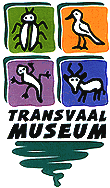
About the Museum
Structure
Shows & Courses
Lectures & Talks
Special Happenings
Contacts & Bookings
|


About the Museum
The Transvaal Museum was founded in 1892 by the Government of the old Zuid-Afrikaansche Republiek, and originally comprised a couple of rooms in a
general museum down in Boom Street, sharing its quarters with the
Cultural History Museum. The collections grew rapidly, and in 1912 the
present building in Paul Kruger Street was erected. No record exists as to the identity of the architect, who most probably worked for the Government at the time.
Zuid-Afrikaansche Republiek, and originally comprised a couple of rooms in a
general museum down in Boom Street, sharing its quarters with the
Cultural History Museum. The collections grew rapidly, and in 1912 the
present building in Paul Kruger Street was erected. No record exists as to the identity of the architect, who most probably worked for the Government at the time.
With the ever-growing collections and increasing functions the museum has to perform, the only alternative was to expand the museum building. The architect Albrecht Holm, of Holm, Jordaan & Holm, and the contractor Lona Construction were commissioned for this purpose.
What are the functions of the museum?
|


 Zuid-Afrikaansche Republiek, and originally comprised a couple of rooms in a
general museum down in Boom Street, sharing its quarters with the
Cultural History Museum. The collections grew rapidly, and in 1912 the
present building in Paul Kruger Street was erected. No record exists as to the identity of the architect, who most probably worked for the Government at the time.
Zuid-Afrikaansche Republiek, and originally comprised a couple of rooms in a
general museum down in Boom Street, sharing its quarters with the
Cultural History Museum. The collections grew rapidly, and in 1912 the
present building in Paul Kruger Street was erected. No record exists as to the identity of the architect, who most probably worked for the Government at the time.